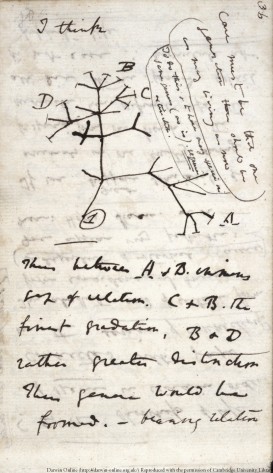First, an explanatory image, taken from a wonderful lecture by evolutionary biologist Lindell Bromham:
And creationists apparently can't stand it when somebody like Brian comes along and says this:On this depiction of the great chain of being you can see that plants are higher than inorganic things, animals are higher than plants, humans are better than animals, angels are above humans and so on. You might say, ‘Oh, we don’t believe in that any more.’ Yet, if you pick up any evolution textbook or even a popular science evolution book, you will often find something that looks very similar to this.
Yes! Having come out of a march-of-progress, great-chain education, I can give you plenty of reasons why it's well past time to break the chain and go to the bank. And don't tell me it's too complicated for kiddies and laypeople to understand, and that a nice, neat line is the best way to introduce folks to evolution. It's not. Far from it.At the beginning of the 20th century, American fundamentalism was gaining momentum and the public circus that was the Scopes trial turned the teaching of evolution into a controversial public issue. Now, at the beginning of the 21st century, anti-scientific opposition to evolution remains a prominent cultural force. Be it straight-up young-Earth creationism or its insidious sibling intelligent design, fundamentalism-fueled views of science and nature abound. Groups such as the National Center for Science Education are continually tracking the spread of anti-evolution agendas which would further erode the quality of scientific understanding. Perhaps this is why we keep returning to the March of Progress. When the fossils and stratigraphy are laid out so plainly, how can any reasonable person deny that evolution is a reality? Yet, by preferring this antiquated mode of imagery, we may have hamstrung ourselves. Given all that we have gleaned about evolution from the fossil record—especially the major pattern of contingent radiations cut back by extinction before bursting into numerous splendid forms all over again—why not bring this wonderful "tangled bank" imagery to the public?
Ultimately, that linear way of explaining evolution set me back several years. Yeah, it may be simple, but it's too simple. It doesn't leave room for all the side trips, dead ends, and scenic routes, and it doesn't give a person room to think outside of a destination. That confused the hell out of me, because there are plenty of things that didn't reach the supposed destination, but were there for a good part of the journey. It's like supposing several cars worth of people can only travel between Phoenix and Flagstaff: you can't explain then why some of them buggered off sideways to Prescott instead.
View Larger Map
Handy map illustrating the concept for those who aren't from the area.
Then I started reading books on evolution. And there was this tree:
 |
| Darwin's Sketch |
Once I saw the tree, started thinking not in chains but in trees and bushes, it started to make sense. Not every branch goes "up." The top of the tree isn't the only place to be. It's still a simple model, but it's one that leaves plenty of room for all the bits that don't fit when you chain yourself to the Great Chain.
That's true in a lot of things about life. It's time to let go of the black/white either/or thinking and embrace the world as it is: fuzzy, chaotic, contingent, and far more interesting than mere lines from A to B.
So grab your bolt cutters, my darlings, and join Brian Switek in cutting those chains.








No comments:
Post a Comment